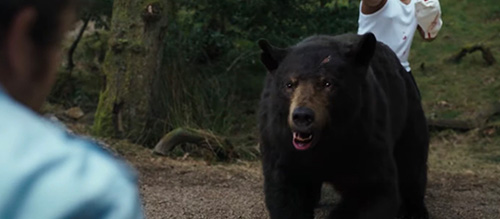Cocaine Bear (2023) Review

Cocaine Bear (2023)
Director: Elizabeth Banks
Screenwriters: Jimmy Warden
Starring: Keri Russell, O’Shea Jackson Jr., Christian Convery, Alden Ehrenreich, Brooklynn Prince, Ray Liotta
In 1985, former narcotics officer and then narcotics trafficker Andrew C. Thornton II flew a plane filled with cocaine in the American southeast. There was so much cocaine on board that Thornton had to dump around seventy-five pounds of it into the Chattahoochee–Oconee National Forest. A bear, which would come to affectionately be known as Pablo Escobear, consumed a considerable amount of the cocaine and died. You can visit Pablo Escobear at the “Kentucky for Kentucky Fun Mall” in Lexington, Kentucky, or you can watch its fictional counterpart in the horror-comedy film Cocaine Bear.
Rather than dying from an overdose, the bear in Cocaine Bear goes on a rampage that makes Tony Montana (Scarface) look small-time. It’s a brutal piece for third-time director Elizabeth Banks, a sharp turn from her previous work on Pitch Perfect 2 and Charlie’s Angels, and she handles the material well. Following Thornton’s comedic death, several groups of characters are confronted by the cocaine bear in a variety of settings and situations that live up to the film’s promised spectacle.
The film’s realist style contrasts well with the more fantastical, mythical elements to lend to the comedy. The opening plays newsreel footage from the 80s that establishes the true story aspects of “based on a true story”, but the film also goes into extremes establishing that this is the 80s with cheesy synths and fringes of the day’s fashion. There are characters with surprising amounts of nuance for how goofy the performances and writing can be. Thanks to James Cameron, filmmakers can finally produce a convincing digital bear that can go on a cocaine bender. This movie would not work as well being played as a straight slasher film with more serious undertones.
An odd couple pairing of gangsters played by O’Shea Jackson Jr. and Alden Ehrenreich get completely different material to work with. Jackson’s character is much more of a straight man to Ehrenreich’s depressed, thoughtful coke dealer who seems straight out of Paul Haggis’ Crash. Ehrenreich seems to have more leeway and fun in his role, a delightful performance that meshes with everyone, while Jackson often seems stuck without any quirks to bring to the forefront. It’s that contrast that makes the duo work, however, and Jackson was well cast for the part.
Other standout performances include the two kids, Christian Convery and Brooklynn Prince. Audiences may be more familiar with Prince’s work in The Florida Project or The Turning, where she has shown herself to be one of the standout child actors in Hollywood right now. She and Convery play a pair ditching school to go paint a waterfall, and they get a chance to show real range despite hardly ever being in harm’s way. It’s clear that Banks’ history as a performer allows her to bring excellence out of the child actors, as it can be difficult for kids to feel natural in a film as ridiculous as this.

It is a shame that Ray Liotta was not given much to do in his final film, however. The veteran actor, best known for a coke-addled character he played in Goodfellas, plays a drug kingpin who is absent for most of the film, a specter driving characters who need to recover the cocaine so they can make money from it. He could have brought a different dynamic and presence to the film, because whatever shifts he does cause comes a bit too late in the story. His transformation into his character through costuming is undeniable, but there is not much to the character beyond “mean drug kingpin in a blonde wig”, which is a real shame.
Is anyone really at Cocaine Bear for the performances? No. They’re here for Cocaine Bear. And Cocaine Bear delivers what the audience wants. The bear savages plenty of characters, tearing limbs and guts from their bodies like a high butcher. It tears apart bags of coke and eats them like a puppy getting into trash. It breathes cocaine snowstorms that characters create to attempts to distract the creature to no avail, because why would more cocaine stop the Cocaine Bear? There’s no grand metaphor here for humanity’s mistreatment of nature through industry, capitalistic consumption in 1980s America, or the ongoing crises created by a perpetual war on drugs – it’s good, old-fashioned fun with a bear on cocaine eating people who have no idea how to deal with a black bear because Wikipedia wasn’t around in the 1980s.
And isn’t that all we ask of any film? To achieve what it wants to achieve? Cocaine Bear isn’t mesmerizing cinema, but it was never expected to be. It’s a B-movie with a decent budget crafted by artists with years of experience in the industry. If the goal is to amuse, and audiences are amused, Cocaine Bear was a success. Maybe one day someone will make an entertaining biopic about Andrew Thornton, too, because that film would be equally nuts without having to move into the realm of fantasy.
Score: 18/24

